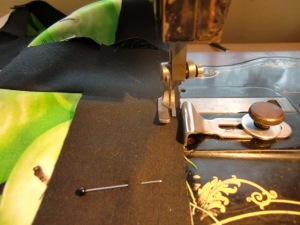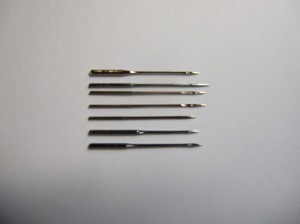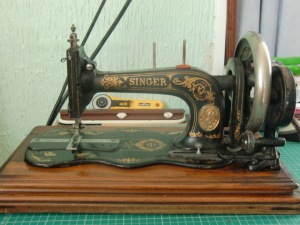Tags
My latest acquisition is a Singer 12 from 1883.
This was also called the Singer New Family and was the first machine that was generally available for household use. I have done some basic cleaning and have been able to get her stitching really well – good enough to piece the blocks for a TreadleOn block exchange I am taking part in, in September.
 Here is a picture of me sewing the blocks on the machine and using the Singer Seam Guide. Absolutely brilliant for getting that 1/4 seam needed for accurate blocks and you don’t need any special feet – as long as you have a screw hole in the bed of the machine to tighten it up.
Here is a picture of me sewing the blocks on the machine and using the Singer Seam Guide. Absolutely brilliant for getting that 1/4 seam needed for accurate blocks and you don’t need any special feet – as long as you have a screw hole in the bed of the machine to tighten it up.
I was lucky with this machine, because although it wasn’t restored at all when I bought it, it was working well and had its boat shuttle, bobbins, and needles that worked.
Needle History
You may not know this but the Singer 12 does not take modern domestic machine needles. At the time the machine was made there were hundreds of different needles made, by many different manufacturers, for different machines. To add to the confusion needles that fit the same machine from different needle manufacturers were numbered differently. Each manufacturer used its own numbering system.
Singer tended to name its needles after the first machine that used them – and with a new needle designed for the Singer 12 they called this needle 12×1 (the first version). They later designed a new needle for their Singer 15 series of machines which has become the 15×1. This needle is now universal (as far as I am aware) for nearly all domestic sewing machines though there are hundreds of different types available for the different industrial machines.
The 15×1 still has equivalent numbering systems which you may be more familiar with depending on where you live – the 130/705H which is used in Europe and also the HAx1 which I think may be an Asian designation.
So the 15×1, the generally available needle does not fit my Singer 12. For this I have to obtain original needles made for the machine – either Singer 12×1 or an equivalent such as the Boye 23 – or obtain an industrial needle that will more or less replace the 12×1 needle.
There is a cross-reference of needles on the ISMACS (International Sewing Machine Collectors Society) website.
http://www.ismacs.net/needle_and_shank/needle-cross-reference-charts.html
It is a spreadsheet showing needle type numbers from old manufacturers that are equivalent to the 12×1 needle, but also includes modern-day industrial needles which have been found to work.
Testing the Needles
I have been doing some testing myself and here is a photo comparing the needles I have tried so far and some notes below on what I have found to work and what I haven’t – at least in my machine.
 1. – Schmetz 130x705H – this needle doesn’t work but I have included as a comparison.
1. – Schmetz 130x705H – this needle doesn’t work but I have included as a comparison.
2. – A needle bought from Alex Askeroff at £5 each as suitable for the Singer 12 – it is marked GB 100. I assume this is a Groz-Beckert needle and the size is 100 but I do not know what system it is – as you can see it has a long point below the eye. This works perfectly.
3. – Original needle supplied with the machine when I bought it – I’m not sure what this is but it works and looks similar to the 339 below. This works perfectly.
4. – A Schmetz system 339 needle size 90 from a packet marked Schmetz Necchi, bought off Ebay for £13.99 for 4 needles.
This works perfectly. Now that I know the size I will look for some cheaper ones!
5. – A needle sent to me from a kind person in the US. It is the smallest from a tube of 3 Boye needles. The system is 23 and the tube is also marked 40-100. This works perfectly.
6. – A Groz-Beckert system DBx1 needle size 80/12 from a packet of 10 bought off Ebay for £2.79.
The ISMACS list states that shanks vary on the DBx1 with Organ being smaller than Schemtz needles. I have yet to measure the shank on this needle but maybe it is also one of the smaller makes which is why I was able to get this to fit, though a bit fiddly. It does push the eye slightly to the left and forward so you would need the needle plate with the larger hole. This works perfectly with the alternative needle plate.
7. – A needle marked 16 100 given to me by the seller as an ‘Industrial 16’ needle. I do not know what system this needle is. It has a large shank and would need the gap in the needle clamp made bigger to use.
The Singer 12 does not have a needle stop like modern machines – meaning that within reason you can move the needle up in the needle clamp in order to get the eye in the correct place for making a stitch. The main issue I feel is with the size of the shank – the 12×1 has a very small diameter round shank. With a larger diameter shank the eye of the needle is pushed slightly to the left and forward, meaning that it could miss the hole and hit the needle plate. Luckily with my machine came a second needle plate with a larger hole, which is supposed to be used for larger size 12×1 needles used for thicker fabric, but I have been able to use it to compensate for the small shift of the needle tip.
You might think that the 15×1 with the flat to the shank would be fine since it might compensate for the increased size of the shank – but the Singer 12 threads front to back, just like many modern machines, and the flat would have to face the back of the machine, meaning that the needle would still be moved to the left, even if the needle was able to fit.
If you have a Singer 12 and have found other easily available needles to fit do let us all know!


Pingback: Singer 12 Circa 1899 | susies-scraps.com
Thank you for posting this. I’ve just acquired a Frister Rossman from 1895 and it only has one needle, so I’m on the hunt. From what I’ve read the Singer 12×1 needles should fit, so I’m looking for alternatives!
LikeLike
So glad you found it useful. Let us know if you have any updates!
LikeLike
Very useful post! I’ve been restoring a Harris Family No 2, made by Stoewer, and now that I’ve come to the point of trying it out I needed to know about needles, and then I found your post. Took me ages today just learning how to thread the shuttle, then couldn’t get the upper thread to catch the lower thread with the one needle that came with the machine. Hopefully I’ll get there in the end.
LikeLiked by 1 person
Been told that groz-beckert my1014b smx1014 size 14 works. I’ve purchased some to try but they haven’t come in yet.
LikeLiked by 1 person
Thanks for that info Theresa. Do let us know how it goes when you get them. Where did you buy them from?
LikeLike
I just got an 1883 Singer 12, different decals but the same machine. It was missing the needle clamp but thanks to your pictures I could fabricate one for it. I ground down a modern needle to the smaller size required for my machine. After oiling it, threading it, and adjusting it, mine sews very nicely!
LikeLike
Hi Jeremiah
Glad you were able to use my photo for your clamp. And also so glad you can now sew with your machine.
Are you in UK? I’m curious to know what the mechanism on yours is for stopping the needle action while winding the bobbin. Mine has a pivot mechanism – not the usual stop motion screw. What does yours have?
If you need any more photos just let me know.
LikeLike
I’m not sure, but mine has a section that I think fits the “stop motion screw” description. It is too tight to loosen, so I just pull the thread out from the needle if I want to wind a bobbin. I did that procedure for the first time this morning and it worked fine.
LikeLike
I was lucky to find an envelope with ten 339 needles. Yes, they work! I think they came from an old industial machine, maybe an overlock.
LikeLike
What a lucky find! I don’t think the 339 is being made anymore so hang on to them. I am thankful I can fit a modern common needle on my 12 but many people are not so lucky.
LikeLike
I’d love a Singer 12 one day. Good to see you are making your canning jar blocks. I really need to get started on mine.
LikeLike
Great post about the needles,… you have done a lot of research! I am so jealous of the nice decals on your Singer 12. Mine are very worn. I’m still fiddling with the stitching, too. Congratulations on getting yours up and running so well!
LikeLike
Thank you for this very helpful information! I recently bought a Singer 12 hand crank, although not nearly as pretty as yours. I love it just the same. I also hope to have it stitching well enough to use for the Treadleon swap in September. I plan to bring my machine to a TOGA in August to get advice for her. Love reading your posts!
LikeLiked by 2 people
Good to hear you are doing blocks for the swap – loved your Cat block! Good luck with the 12.
LikeLike
Very useful notes on needle types and sizes for the Singer 12 – thank you Sam – any chance you could post it on the ISMACS Digest too?
P.
LikeLike
Will try and get round to that once I’ve actually bought a micrometer and taken some measurements :0) Thanks for the thought.
LikeLike